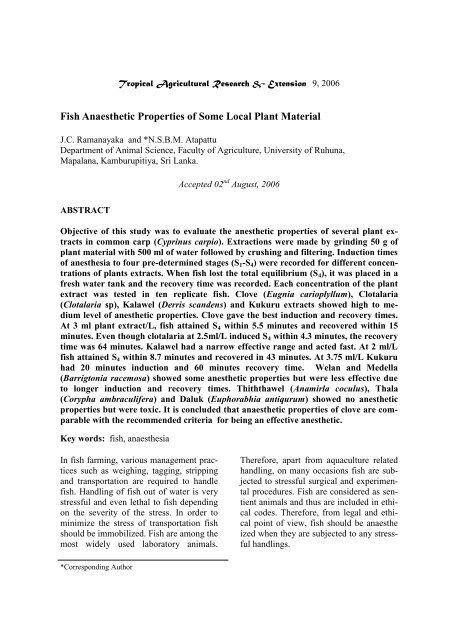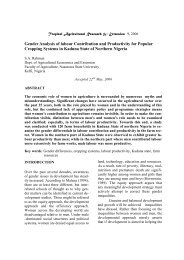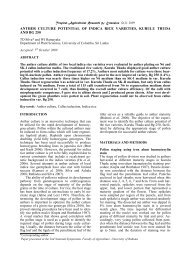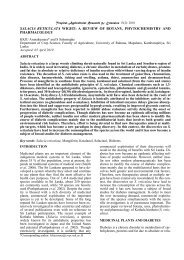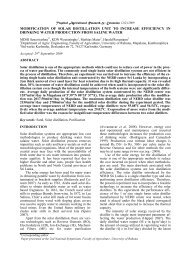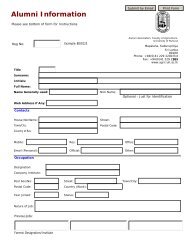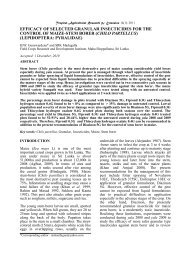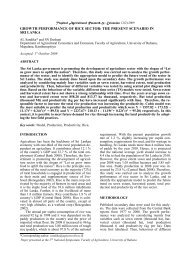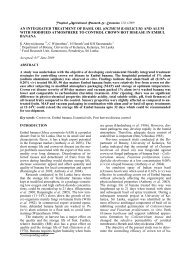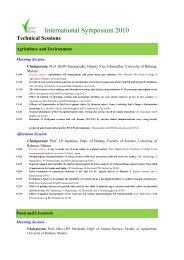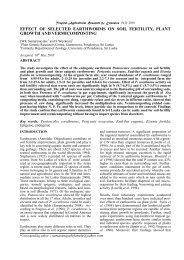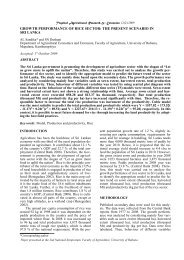Fish Anaesthetic Properties of Some Local Plant Material - Faculty of ...
Fish Anaesthetic Properties of Some Local Plant Material - Faculty of ...
Fish Anaesthetic Properties of Some Local Plant Material - Faculty of ...
You also want an ePaper? Increase the reach of your titles
YUMPU automatically turns print PDFs into web optimized ePapers that Google loves.
Tropical Agricultural Research & Extension 9, 2006<strong>Fish</strong> <strong>Anaesthetic</strong> <strong>Properties</strong> <strong>of</strong> <strong>Some</strong> <strong>Local</strong> <strong>Plant</strong> <strong>Material</strong>J.C. Ramanayaka and *N.S.B.M. AtapattuDepartment <strong>of</strong> Animal Science, <strong>Faculty</strong> <strong>of</strong> Agriculture, University <strong>of</strong> Ruhuna,Mapalana, Kamburupitiya, Sri Lanka.Accepted 02 nd August, 2006ABSTRACTObjective <strong>of</strong> this study was to evaluate the anesthetic properties <strong>of</strong> several plant extractsin common carp (Cyprinus carpio). Extractions were made by grinding 50 g <strong>of</strong>plant material with 500 ml <strong>of</strong> water followed by crushing and filtering. Induction times<strong>of</strong> anesthesia to four pre-determined stages (S 1 -S 4 ) were recorded for different concentrations<strong>of</strong> plants extracts. When fish lost the total equilibrium (S 4 ), it was placed in afresh water tank and the recovery time was recorded. Each concentration <strong>of</strong> the plantextract was tested in ten replicate fish. Clove (Eugnia carioplyllum), Clotalaria(Clotalaria sp), Kalawel (Derris scandens) and Kukuru extracts showed high to mediumlevel <strong>of</strong> anesthetic properties. Clove gave the best induction and recovery times.At 3 ml plant extract/L, fish attained S 4 within 5.5 minutes and recovered within 15minutes. Even though clotalaria at 2.5ml/L induced S 4 within 4.3 minutes, the recoverytime was 64 minutes. Kalawel had a narrow effective range and acted fast. At 2 ml/Lfish attained S 4 within 8.7 minutes and recovered in 43 minutes. At 3.75 ml/L Kukuruhad 20 minutes induction and 60 minutes recovery time. Welan and Medella(Barrigtonia racemosa) showed some anesthetic properties but were less effective dueto longer induction and recovery times. Thiththawel (Anamirla coculus), Thala(Corypha ambraculifera) and Daluk (Euphorabhia antiqurum) showed no anestheticproperties but were toxic. It is concluded that anaesthetic properties <strong>of</strong> clove are comparablewith the recommended criteria for being an effective anesthetic.Key words: fish, anaesthesiaIn fish farming, various management practicessuch as weighing, tagging, strippingand transportation are required to handlefish. Handling <strong>of</strong> fish out <strong>of</strong> water is verystressful and even lethal to fish dependingon the severity <strong>of</strong> the stress. In order tominimize the stress <strong>of</strong> transportation fishshould be immobilized. <strong>Fish</strong> are among themost widely used laboratory animals.Therefore, apart from aquaculture relatedhandling, on many occasions fish are subjectedto stressful surgical and experimentalprocedures. <strong>Fish</strong> are considered as sentientanimals and thus are included in ethicalcodes. Therefore, from legal and ethicalpoint <strong>of</strong> view, fish should be anaestheized when they are subjected to any stressfulhandlings.*Corresponding Author
J.C. Ramanayaka & N.S.B.M. Atapattu : <strong>Fish</strong> <strong>Anaesthetic</strong> <strong>Properties</strong> <strong>of</strong> <strong>Local</strong> <strong>Plant</strong> <strong>Material</strong>sChemical anesthetics are now widelyused for fish anesthesia. The chemical anestheticsused in fish have changed gradually(Stuart 1985). Many <strong>of</strong> the first generationanesthetics such as ether, chlor<strong>of</strong>orm,menthol, urethane and cocaine arenow not in use due to, health hazards, lack<strong>of</strong> adequate efficacy and adverse physiologicaleffects on fish. The second generation<strong>of</strong> fish anesthetics are the chemicalssuch as tricaine, benzocaine and quinaldine.Though these anesthetics are effective,only tricaine has been permitted touse in food fish anesthesia mainly due toenvironmental and health risks (Markingand Mayer, 1985). This has resulted in arenewed interest to develop ‘green anaesthetic’with low environmental and healthrisks.Though the term anesthesia is technical,for thousands <strong>of</strong> years people used plantextract to kill or immobilize fish. Theseplant extracts are added to water in variousforms and ways. The efficacy variesgreatly from light sedation to killing. Theobjective <strong>of</strong> the present study is to evaluatethe fish anaethetic properties <strong>of</strong> someplant materials commonly used by SriLankan fishermen to immobilize or to killfish.Extracts <strong>of</strong> ten plant materials were usedfor the experiment (Table 1).The method <strong>of</strong> extraction was similar forall pant materials except for Thiththa Wel.50 g <strong>of</strong> fresh pant material were blended ina kitchen blender (300 rpm) with 500 ml <strong>of</strong>distilled water.Then the extract was collected into a flaskby crushing and filtering through a pieceTable 1. <strong>Plant</strong> materials studied for fishanesthetic propertiesCommonnameBotanicalnameplant part usedto get extractClove Eugnia ariophylumdry flower budsClotalaria Clotalaria spp leavesKalawel Derris scandens stemKukuruWelanMedellaAnduBarringtoniaraecemosaEryagaum foetidanyThithawel Anamirla cocculusThala Corypha ambraculiferaDaluk Euphorabiaantiquarumnut (fruits)nut (fruits)barkwhole plantNutnut (fruit)stem<strong>of</strong> cotton cloth. The method <strong>of</strong> extractionfor Thiththa Wel was as follow; 50 g <strong>of</strong>fresh nut <strong>of</strong> Thiththa Wel was mixed with5 ml <strong>of</strong> coconut oil and then crushed togetherusing a motar and pestle. 55 g <strong>of</strong>this mixture was then mixed with 500 ml<strong>of</strong> water and belnded. The extraction wascollected by crushing and filtering thougha cotton cloth.2-3 months old common carp (Cyprinuscarpio) <strong>of</strong> indeterminate sex was used forthe experiment. <strong>Fish</strong> were kept in an outdoorcement tank before being used for theexperiment. A pre-trial was conducted toestablish the effective dose range <strong>of</strong> eachplant extract.A glass tank (45 L * 25 W*29.5 H cm)was filled upto 18 cm with fresh tap waterso that the tank contains 20 l <strong>of</strong> water. A
Tropical Agricultural Research & Extension 9, 2006measured volume <strong>of</strong> plant extract wasadded to the water and mixed thoroughlyfor 20 seconds. Then a fish was introducedinto the tank. The time taken toreach pre determined stages <strong>of</strong> anaesthesiawas taken (Table 2).Table 2. Stages <strong>of</strong> anesthesia and theircharacters (Modified from Stuart 1985).Stage <strong>of</strong>anesthesiaCharacters used to identify1 Loss <strong>of</strong> equilibrium, but fish respondedto tactile stimuli2 reduced response, partial loss <strong>of</strong> equilibrium,fish can hold on hand, reducedoperculum activity3 loss <strong>of</strong> response, can pull by posteriorfin4 total loss <strong>of</strong> equilibrium, fish lay downAs soon as the fish reached to S 4 anesthesia,it was transferred to a glass tankfilled with 40 l <strong>of</strong> fresh tap water. Thetank was aerated with normal circuit <strong>of</strong>aerator. The time taken to gain the completeequilibrium was taken as the recoverytime. Each concentration <strong>of</strong> all theplant extracts was replicated in 10 fish. N<strong>of</strong>ish was reused. The weight <strong>of</strong> the fishvaried from 100-150 g.Time taken to reach different stages <strong>of</strong> anesthesiaand recovery time from S 4 aregiven in Table 3.The effectiveness <strong>of</strong> the plant extractswas decided on the time taken to reach toS 4 anesthesia and the recovery time. Markingand Mayer (1985) recommended desirableinduction and recovery times <strong>of</strong> anesthesia<strong>of</strong> fish as 3 and 5 minutes, respectively.None <strong>of</strong> the tested plant extract metthe recommended induction and recoverytime regimes. This less effectiveness withrespect to induction and recovery timesmay partly be due to the low concentration<strong>of</strong> active ingredients in the crude plant extractswe used. Much <strong>of</strong> the fish anestheticstudies have been conducted in salmonidswhose oxygen demand is high (Sedgwick(1985). The transfer <strong>of</strong> anesthetics to andfrom the fish takes place via the gills andthus the effectiveness <strong>of</strong> anaesthetics inthese active fishes are higher compared tocarps. The observed less effectiveness maybe attributed to this fact as well.Despite the fact that plant extracts are notas effective as an ideal anesthetic shouldbe, a considerable level <strong>of</strong> anesthetic propertiescould be found even in crude plantextracts. Clove, Clotalaria, Kalawel andKukuru extracts showed high to mediumlevels <strong>of</strong> anesthetic properties. Clotalariaat 3-3.75 ml/l level gave around 3 minutesinduction time. However, recovery timewas far exceeded the recommended time.Clove at 3 ml/l gave the closest charactersto the ideal anesthetic. Munday and Wilson(1997) and Peake (1998) have alsoreported the anesthetic properties <strong>of</strong> cloveoil. We observed 5.5 minutes inductiontime and 15 minutes recovery times at 3ml/l concentration. Peake (1998) reported6 minutes <strong>of</strong> induction and 7 minutes <strong>of</strong>recovery time for clove oil. Values weobserved were more or less similar to thevalues reported by Gilderbus and Marking(1987) for CO 2 at 240-265 mg/l; i.e 3.1minutes induction and 16 minutes recoverytime. Marking and Mayer (1985) showedthat CO 2 was stressful and lethal after repeatedexposure because CO 2 acidifies waterand reduces desolved O 2 . Other adverse
J.C. Ramanayaka & N.S.B.M. Atapattu : <strong>Fish</strong> <strong>Anaesthetic</strong> <strong>Properties</strong> <strong>of</strong> <strong>Local</strong> <strong>Plant</strong> <strong>Material</strong>sTable 3. Time taken to reach different stages <strong>of</strong> anesthesia and to recover as affectedby the plant extract and the concentration.Time taken to reach different stages <strong>of</strong> anesthesia and recovery (Min)<strong>Plant</strong> extract Concentration (ml/l) S1 S2 S3 S4 RecoveryClove 1 1.5 4.30 7 12 22 72 4.5 5.3 7 11 92.5 3 4 5 6 143 3 4 5 5.5 15.Clotalaria 1 1.25 1.1 3.6 8.4 17.7 602.5 0.6 1.3 2.1 4.20 643.75 1.3 1.4 2.3 3.3 84.35 1.2 1.6 2.1 3.2 116.1Kalawel 1 2 2.7 4.1 5.6 8.7 432.25 2.4 3.6 5.5 8.1 57.12.5 2 3.9 6.2 8.6 80.52.75 2 3.4 4.4 6.2 161.2Kukuru 1 1.25 21 31 33 50 102.5 7 10 21 33 173.75 7 9 17 20 605 7 10 18 20 90Welan 1 5 27.8 44.9 75.3 102. 24.27.5 11.6 19 25.1 35.7 40.915 5.9 9.2 13.7 20.1 53.7Medella 5 20 31.7 42.5 53.7 106.715 9.8 14 17.3 23.4 135.3Andu 2 2.5 41 755 25 46.6Thithawel 3 5 35 46.6 56.6 66.610 18.6 25 33 45.3Thala 3 2.5 22.6 33.3 42 50.6Daluk 3 5 13.6 22.6 38.6 431 Means <strong>of</strong> ten fish. No fish died2 Studied only up to S 23<strong>Fish</strong> died
Tropical Agricultural Research & Extension 9, 2006effects <strong>of</strong> CO 2 include erythrocute swelling,increased lactic acid levels and reducedoxygen partial pressure in blood. Sincemany countries have now banned chemicalanesthetics in aquacultural practices clovecan be recommended as an effective anaestheticagent for food fish.<strong>Some</strong> doses <strong>of</strong> Clotalaria and Kalawelshowed fairly effective induction times.However, both <strong>of</strong> these plant extracts hadmuch longer recovery times. Kalawelcould be identified as the most effective ininducing anaesthesia. Also it had narrowdose range <strong>of</strong> effectiveness. Even at 2 ml/lconcentration it caused S 4 anaesthesiawithin 8.7 minutes but took 43 minutes torecover. The effectiveness <strong>of</strong> Kalawel iscomparable with chemical anesthetic ChoralHydrate at 0.9g/l (Stuart 1985). Kukurualso showed some anesthetic properties.3-3.75-5 ml/l concentration caused S 4in 20 minutes. Interestingly concentrations<strong>of</strong> 1.25 and 2.5 ml/l <strong>of</strong> kukuru and 5 ml/l<strong>of</strong> welan had shorter recovery times thantheir respective induction times. No chemicalanaesthetic has shown to have thisproperty. The reason for this peculiarity isnot clear.Welan and Medella can also be categorizedas slow acting plant extracts. Toachieve S 4 in 20 minutes both welan andmedella required as high dose as 15 ml/l.The recovery times were also high forthese plant extracts. The longer recoverytimes <strong>of</strong> these extracts may be helpfulwhen fish are transported for a long distanceunder anesthesia. Stuart (1985)compiled the chemical anesthetics suitablefor fish transportation under anesthesia.Anesthetic properties <strong>of</strong> Welan andMedella fairly comparable with the chemicalsmetomidate and etomidate at 0.75 and1 mg/l. Andu was the least effective. Sinceit took 46 minutes to reach S 2 at 5ml/l, weassumed that anesthetic properties <strong>of</strong> anduwas not study worthy. Thiththawel, Thalaand Daluk showed no anesthetic properties.They were found to have toxic effectsthan anesthetic properties (as claimed byindigenous knowledge) since all the fishexposed to above plant extracts did notrecover but died.<strong>Fish</strong> were observed for five days afterthe completion <strong>of</strong> the study. No fishanaesthetized with Clove, Cloralaria,Kalawel, Kukuru, Welan, Midella andAndu died during that period and fishshowed normal activity indicating thatthose plant extracts have no adverse effects.However, how these plant extractsaffect the physiological processes are notclear. Therefore, further experiments needto be conducted to establish such effect, ifany, if fish are to be anaesthetized usingthese extracts, for physiologica experiments.<strong>Anaesthetic</strong> properties <strong>of</strong> Clotalaria,Kalawel and Kukuru were found tobe sufficient enough for many aquaculturalpractices. Welan and medella couldbe useful for fish transportation. Andu,thala, thithawel and daluk should not beused as an anaesthetics. Further researchesare needed to identify the active ingredientsand possible effects on physiology <strong>of</strong>the fish.REFERENCESGilderhus, P.A. and Marking, L.L (1987).Comparative efficacy <strong>of</strong> 16 anaestheticchemicals in rainbow trout.North American Journal <strong>of</strong> <strong>Fish</strong>eriesManagement.
J.C. Ramanayaka & N.S.B.M. Atapattu : <strong>Fish</strong> <strong>Anaesthetic</strong> <strong>Properties</strong> <strong>of</strong> <strong>Local</strong> <strong>Plant</strong> <strong>Material</strong>sMarking, L.L. and Mayer, F. (1985). Arebetter anaesthetics needed in fisheries.<strong>Fish</strong>eries. 10(6):2-5Munday, P.L. and Wilson, S.K. (1997).Comparative efficacy <strong>of</strong> clove oiland other chemicals in anaesthetic <strong>of</strong>coral reef fish. Journal <strong>of</strong> <strong>Fish</strong> Biology.51(5):931-938.Peake, S. (1998). Sodium bicarbonate andclove oil as potential anaesthetic fornon salmonid fishes. North AmericanJournal <strong>of</strong> <strong>Fish</strong>eries Management.18:919-924.Sedgwick, C.J. (1988). Anaesthesia forfish. Veterinary Clinic in NorthAmerica: Food and Animal Practice.21(3): 737-742.Stuart, N.C. (1985). Anaesthesia in fish.Journal <strong>of</strong> Small Animal Practices.22:377-384.


